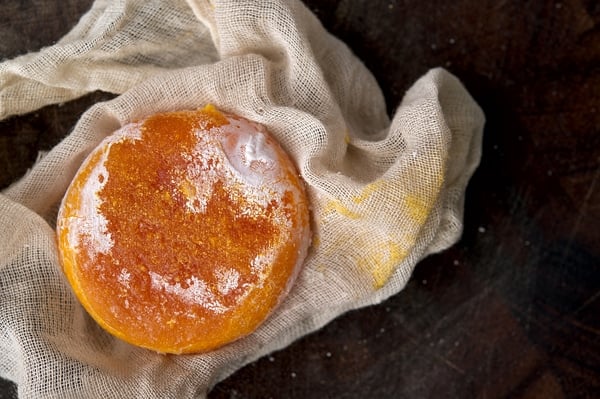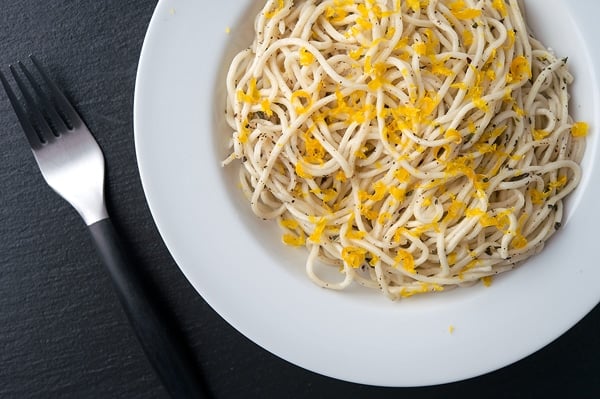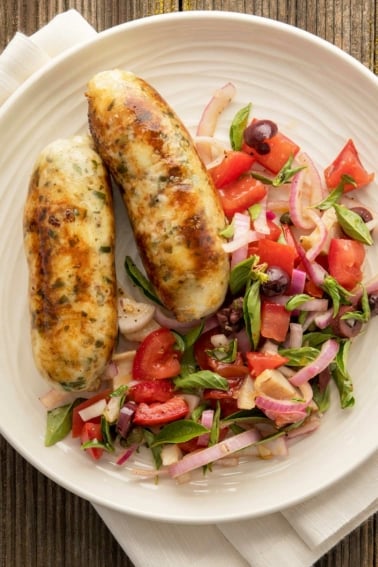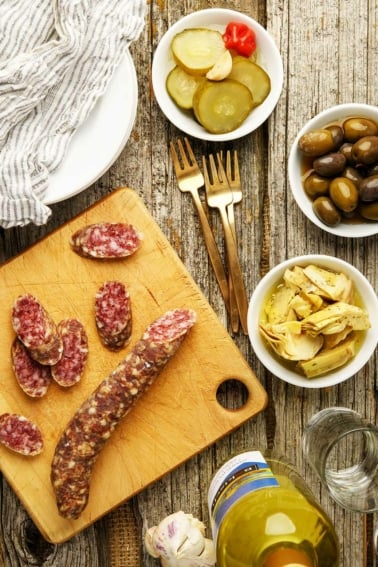As an Amazon Associate I earn from qualifying purchases.

Egg yolks are one of the most magical of foods. Chefs all over the world wax poetic about them, but it’s hard to understand why when all you might be exposed to are the wan, watery, factory-farmed yolks you see in most supermarkets. A golden treasure they are not.
You can only understand the joy — lust, even — over an egg when you finally see (and taste) a real egg, eggs from chickens raised on grass and bugs and whatever else it is that a hen loves to nibble throughout the day.
Before I’d encountered such eggs, when I saw pictures of Italian egg pasta, I thought they were retouched: Their pasta is always bright yellow. As much as I tried, I found it impossible to duplicate with eggs from the supermarket. I talked to Italian pasta makers and they said you need yolks of a truly golden, almost orange, hue. That’s what gives you that pretty color.
I came into possession of such eggs from my friend Teala’s father, who raises ducks and geese in my neighborhood. It’s what I prefer to use for my pasta, and, just like the Italian pasta pictures I swooned over, the photos on this post are not retouched. This is precisely how yellow they actually are.
Not too long ago, Teala’s dad gave me two goose eggs along with the duck eggs. I was amazed at their size. I cracked one open and made an entire batch of pasta with that one egg. I was shocked at how orange the yolk was — brighter even than the duck eggs.
I wanted to capture that color, that richness. I’d known about salt cured egg yolk for a few years; my friends, Chefs Brad Cecchi and Oliver Ridgeway at Grange in downtown Sacramento had first clued me into it. Basically you bury egg yolks in salt, then dry them out until they are like a very hard cheese. This is exactly how you use them — as a golden, eggy, über rich substitute for grated cheese over pasta or rice.
Brad and Oliver never explained to me exactly how to do this, but fortunately Chef Jeffrey Weiss does in his remarkable book Charcutería: The Soul of Spain. You will be seeing a lot of this book in the months to come. I am mildly obsessed with it and have already made a half-dozen or so of its recipes, ranging from salami to sausages to cured fish and now, here, salt cured egg yolks.
If you’ve never cured anything in your life, this would be a good place to start. It’s really easy and comes together in about 2 weeks. And once you’ve made the cured yolks, you can use them over pasta for months.
What else can you do with cured egg yolk? Not sure. I eat a lot of pasta. What would you suggest?

Grate your egg yolks over any of these pasta recipes.
Salt Cured Egg Yolk
Ingredients
- Egg yolks
- Salt
- Cheesecloth
Instructions
- Get yourself two containers: One for the whites, so you can do something with them later, and one to cure the yolks. You will need to lay down a half-inch layer of kosher salt in the bottom of your curing container; you can go a little deeper if you want. Make little depressions in the salt to hold the egg yolks.
- Crack the eggs and separate them. Gently lay the yolk in one of the depressions and repeat until you have all your eggs in the container. Now bury them in more salt.
- Keep the yolks buried in the salt for a week in the refrigerator. Take them out -- the yolks will be firm and a little tacky still -- and carefully brush off the salt. You might need to remove the salt with a damp paper towel.
- Wrap the yolks loosely in cheesecloth and hang them in the fridge until they are dry, about 7 to 14 days. Store in the cheesecloth in a closed container in the fridge.
Notes
Nutrition information is automatically calculated, so should only be used as an approximation.





Any tips on how to hang them in the fridge? I’m imagining strung over a wooden spoon resting over a bowl?
Melissa: Sure. Bundle up in cheesecloth and use a twist tie to hand from a shelf bracket in the fridge.
Mind blown
Have duck eggs.. Will try. Never heard of this.
Curious, have you ever attempted to freeze them after they are cured?
Does it matter what salt you use, other than maybe staying away from an iodized salt?
Christianne: I like a fine grained sea salt. Seems to cover the yolks more cleanly.
Any chance we could see how you “hang” the yolks in the fridge?
Alex: Just fold them up in cheesecloth and use a twist tie to attach the bundle to the underside of a fridge rack.
I’ve seen a lot of differing instructions for time buried in the salt. I’ve done about 8 and I plan on experimenting taking one out of the salt and hanging very 2 days. I took my first out today.
Are they hung together in the cheese cloth (touching each other) or separate?
Stephen: Separate.
You mentioned Sacramento so I assume your fairly local. I’m in Placerville am have around 40 amazing chickens and amazing eggs. Dark orange yokes. I will be giving this a try! If you ever need eggs- you can look me up on FB! Nicolecargo84@gmail.com
Also, what’s the longest they should hang in the cheese cloth? And, how is it best to store them when they’re done drying?
Thank you so much!
I can’t wait to try them. I made 2 dozen!
Tasha: I’ve hung them in the cheesecloth a year. They get brittle though. And you just need to get off most of the salt, not all.
Ok, Mine are duck eggs and they’re coming out of the salt today. They look lovely! A little sticky still, but according to what I’ve read here it sounds like that’s ok. You mention using a wet paper towel to get the salt off. How much salt do I need to get off? Is it ok if there is a bit left? I used a regular towel to gently brush off the excess. But, I’m afraid to go further.
Raised on a turkey farm…this works amazing with turkey eggs (which are also waaaaay more delish than chicken eggs
Also, before I read the comments I had already added the top layer of salt and I noticed I had a couple of yolks that were leaking. Do you think it will be ok?
If I want to do a dozen duck yolks at once any recommendations on HOW to hang gem dry in the fridge?
Tasha: In cheesecloth from the racks. As for the leaking yolks, it’s not ideal. I’d re-do it.
Whole salted eggs have been eaten in Asia for centuries as an accompliment to rice. The Chinese put salted duck yolks in their mooncakes eaten during the autumn solstice festival: a taste of the sweet lotus paste and bits of the salty yolk is extraordinary. Now adays Asian chefs have taken the salted yolks into new heights. It is a rage right now in highend restaurants; pumpkin with salted eggs, crabs with salted eggs, sponge cake layered with salted eggs , these are but a few of the versitality of the humble egg.
What I love about Allen’s comment is if it were TRUE you’d see orange/golden yolks in production eggs.
I have an abundance of quail eggs so am gonna try with those. Thinking they’ll be a little faster to cure?
Yes, probably 3 days faster
Thank you for the recipe,
My only question is, how long can an uncooked yolk be outside of it’s eggshell?
Isn’t it going to turn bad after two weeks, even in the fridge?
General rule of the thumb is to eat raw eggs very fresh, if at all..
Valid point for salmonella too 🙂
Mariya: Not sure what you mean. The yolk is buried in salt, which kills all bacteria. No chance of salmonella. I’ve had these a year old and they’re fine — the salt protects you.
“Charcuteria, The Soul of Spain” was the reason I spent 5 weeks last Spring eating Jamon and other delights. The salt cured yolks can be used for making the most amazing eggs you will ever eat. Much like using “lobster butter” for Lobster, or juicing carrots or asparagus then using those juices to steam or sautee’ those respective vegetables. Once you use these yolks as a garnish for any egg dish, you will be addicted!
Sadly, the Italian eggs you’re talking about have such rich yellow yolks because the hens are fed colouring. Not unlike farmed salmon, which is fed a range of artificial colouring to mimick the natural colour of wild salmon.
Of course real eggs still exist, but few people indeed have access to them – and surely not through the retail chain.
Just as with salmon, people are so addicted to the colour that the pale custard (or egg noodles, or croissants – you name it) obtained using organic or even simply plain, uncoloured eggs (the “special”, coloured ones are sold in separate boxes) don’t sell as well as the ones made from artificially coloured eggs. Even my mentor in patisserie – a chef with 40+ years of experience, maintains they have a better “flavour” (which is plainly impossible, given these are inferior eggs laid by caged hens).